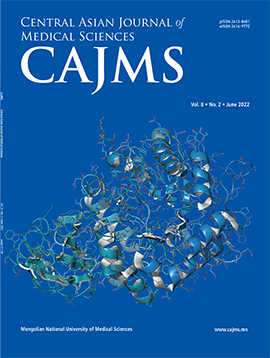The Use of Double Test Biomarkers to Predict Fetal Nuchal Translucency Thickness in the Diagnosis of Trisomy 21: A Compromise between Sensitivity and Specificity
DOI:
https://doi.org/10.24079/cajms.2018.09.009Keywords:
Down Syndrome, First Trimester Serum Biomarker, Fetal Nuchaltranslucency Thickness, Sensitivity, SpecifcityAbstract
Objectives: The aim of study is to determine the sensitivity and specificity of screening for fetal trisomy 21 in the first trimester of pregnancy using a combination of maternal serum biomarkers and ultrasonography. The objectives of this study were to first duplicate and confirm within the Mongolian population, the results of other similar studies. Our results corroborated closely with those of other studies and further allowed us to draw conclusions and recommendations unique to Mongolia. A second objective was to apply these results to everyday obstetric practices within Mongolia and advance the state of prenatal care for all Mongolian women. Methods: Obstetric History: The obstetric history was recorded, and serum biomarkers were measured in 415 pregnancies.The degree of risk for trisomy 21 and other fetal aneuploidy were calculated using maternal age, the results of maternal serum pregnancy-associated plasma protein-A, free beta human chorionic gonadotropin, and fetal nuchal translucency thickness. Grouping of Test Subjects: Using a cut-off risk estimate of 1 in 300, the women were grouped into positive and negative screening groups. Sensitivity and specificity of the screening method were calculated from the available data. Results: Sensitivity of the screening test for fetal trisomy 21 was 66.6% and for all fetal aneuploidy was 83%. Specificity of the screening test for fetal trisomy 21 was 87.5% and for all fetal aneuploidy was 97.8% and the false positive rate was 2.2%. Our results are consistent with the results obtained in other international studies. Conclusions: Our study is unique in that it is the first such scientific examination of mothers at risk for congenital abnormalities in Mongolia. This study provides empirical evidence that the combination of the double test, maternal age, and fetal nuchal translucency thickness is an effective prenatal screening method for fetal aneuploidy pregnancy outcomes in Mongolia.
Downloads
218
Downloads
Published
How to Cite
Issue
Section
License
Copyright (c) 2018 Mongolian National University of Medical Sciences

This work is licensed under a Creative Commons Attribution-NonCommercial 4.0 International License.




